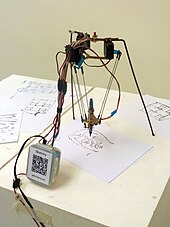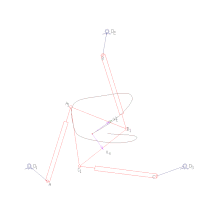Delta robot
This article needs additional citations for verification. (October 2009) |


A delta robot is a type of
Delta robots have popular usage in picking and packaging in factories because they can be quite fast, some executing up to 300 picks per minute.[4]
History

The delta robot (a parallel arm robot) was invented in the early 1980s by a research team led by professor
The purpose of this new type of robot was to manipulate light and small objects at a very high speed, an industrial need at that time.In 1987, the Swiss company Demaurex purchased a license for the delta robot and started the production of delta robots for the
In 2017, researchers from
Design


The delta robot is a
The key concept of the delta robot is the use of parallelograms which restrict the movement of the end platform to pure translation, i.e. only movement in the X, Y or Z direction with no rotation.
The robot's base is mounted above the workspace and all the
Since the actuators are all located in the base, the arms can be made of a light composite material. As a result of this, the moving parts of the delta robot have a small inertia. This allows for very high speed and high accelerations. Having all the arms connected together to the end-effector increases the robot stiffness, but reduces its working volume.
The version developed by
Currently other versions of the delta robot have been developed:
- Delta with 6 degrees of freedom: developed by the Fanuccompany, in this robot a serial kinematic with 3 rotational degrees of freedom is placed on the end effector
- Delta with 4 degrees of freedom: developed by the Adeptcompany, this robot has 4 parallelogram directly connected to the end-platform instead of having a fourth leg coming in the middle of the end-effector
- Pocket Delta: developed by the Swiss company Asyril SA, a 3-axis version of the delta robot adapted for flexible part feeding systems and other high-speed, high-precision applications.
- Delta direct drive: a 3 degrees of freedom delta robot having the motor directly connected to the arms. Accelerations can be very high, from 30[10] up to 100 g.
- Delta cube: developed by the EPFLuniversity laboratory LSRO, a delta robot built in a monolithic design, having flexure-hinges joints. This robot is adapted for ultra-high-precision applications.
- Several "linear delta" arrangements have been developed where the motors drive linear actuators rather than rotating an arm. Such linear delta arrangements can have much larger working volumes than rotational delta arrangements.[11][12]
The majority of delta robots use rotary actuators. Vertical linear actuators have recently been used (using a linear delta design) to produce a novel design of
These offer advantages over conventional leadscrew-based 3D printers of quicker access to a larger build volume for a comparable investment in hardware.Applications

Industries that take advantage of the high speed of delta robots are the food, pharmaceutical and electronics industry.[16][17] For its stiffness it is also used for surgery, in particular, the Surgiscope is a delta robot used as a microscopic holder system.[18]
The structure of a delta robot can also be used to create
References
- ^ "Sketchy, a home-constructed drawing robot". Jarkman.
- ^ Bonev, I. (2001) Delta Parallel Robot — the Story of Success, Online article available at http://www.parallemic.org/Reviews/Review002.html
- ^ a b Bonev, I. The True Origins of Parallel Robots. Online article available at http://www.parallemic.org/Reviews/Review007.html
- ^ "Robotics News & Articles".
- ^ US 4976582, Clavel, Reymond, "Device for the movement and positioning of an element in space", published 1990-12-11, assigned to Sogeva SA
- ^ Laure-Anne Pessina (7 March 2012). "Reymond Clavel, creator of the Delta Robot reflects on his career". EPFL. Archived from the original on 27 October 2018. Retrieved 19 January 2018.
- ^ a b Clavel, R. (1991) Conception d'un robot parallèle rapide à 4 degrés de liberté. PhD Thesis, EPFL, Lausanne, Switzerland
- IEEESpectrum.
- ^ Merlet, J.-P., Parallel Robots, Kluwer Academic Publishers, 2000.
- ^ Miller, K., "Modeling of Dynamics and Model-Based Control of DELTA Direct-Drive Parallel Robot," Journal of Robotics and Mechatronics, Vol. 17, No. 4, pp. 344-352, 1995.
- ^ "Gallery of robots - prof. Reymond Clavel"
- ^ Reymond CLAVEL. "Robots parallèles" Archived 20 September 2018 at the Wayback Machine
- ^ Johann Rocholl (6 February 2012). "Rostock (delta robot 3D printer)". Thingiverse.
- ^ Mike Szczys (13 July 2012). "3D printing with a delta robot that seems to simplify the concept".
- ^ "Hoosier Daddy – The Largest Delta 3D Printer in the World". 3D Printer World. Punchbowl Media. 23 July 2014. Archived from the original on 26 October 2014. Retrieved 28 September 2014.
- ^ "Delta Parallel Robot - the Story of Success". www.parallemic.org. Retrieved 30 December 2023.
- ^ "New Delta Robots Handle Primary Food Packaging". Packaging World. 1 August 2022. Retrieved 30 December 2023.
- S2CID 17649458. Retrieved 30 December 2023.
- ^ Sunny Bains (8 August 2007). "Feeling virtual worlds".
- S2CID 224881163.
